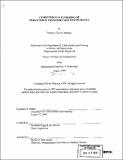Competition in tendering of urban public transport services in France
Author(s)
Duporge, François-Xavier (François-Xavier Pierre Henri), 1964-
DownloadFull printable version (5.748Mb)
Other Contributors
Massachusetts Institute of Technology. Dept. of Urban Studies and Planning.
Advisor
Nigel H.M. Wilson.
Terms of use
Metadata
Show full item recordAbstract
The French tendering system for urban public transport services, introduced by the Sapin law in 1993, has often been criticized for its lack of competition. In order to check the relevance of this criticism, this thesis examines the degree of competition in the French market, using two surveys of the outcomes of tenders in the urban public transport networks outside the Paris region. The first one was conducted by the CER TU ( Centre d'Etudes sur les Reseaux, les Transports, l'Urbanisme Et les Constructions Publiques) in 1996. The second survey, undertaken in 1999 as part of this thesis research, focused on networks serving a population over 200,000 inhabitants and is based on the official minutes of the organizing authorities on the deliberation of the delegation of urban public transport services, and interviews conducted with organizing authorities, operators, and several organizations involved in urban public transport in France. Based on these two surveys, it is established that there is a small number of participants in most French tenders and that the operators in general lack competitive behavior. From this evidence, the thesis identifies five reasons for the lack of competition in the French tendering system. One obstacle is regulatory: labor law L122.12, which imposes the renewal of employment contracts on the new incumbent. The other four obstacles are: asymmetries among bidders, high tendering costs, high operation risks, and the OA' s perceived failure to conduct a fair selection. A literature review of the relevant theories on competition, industry concentration and tendering, is conducted in order to support the analysis of obstacles to competition in French tendering with the necessary theoretical background. It is then shown that all the five factors are barriers to entry, and that they should be removed, or at least reduced, in order to stimulate the entry of new competitors and therefore true competition. The thesis concludes with a presentation of a set of three strategies to improve the competition in the French market, that could be implemented within the current regulatory framework, that is to say, without modifying labor law L122-12. For each strategy, the tradeoffs between increased competition and effectiveness and quality of service are discussed. The first strategy consists of the reduction in the bundle size of service to be tendered out. The second strategy proposes a reduction of contract duration, and the third strategy consists in the improvement of the specification and selection process. It is recommended to combine all three strategies together for maximum impact on competition; this impact may however be modest, as a major barrier to entry, labor law L122-12, has not been removed. The modest increase in the number of bidders that could be achieved may still lead to an improvement in competition, and therefore in price.
Description
Thesis (S.M.)--Massachusetts Institute of Technology, Dept. of Urban Studies and Planning, 1999. Includes bibliographical references (leaves 86-89).
Date issued
1999Department
Massachusetts Institute of Technology. Department of Urban Studies and PlanningPublisher
Massachusetts Institute of Technology
Keywords
Urban Studies and Planning.